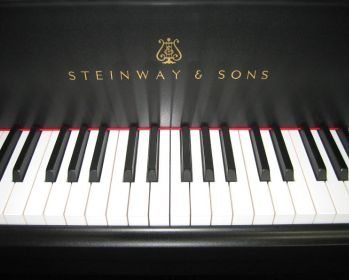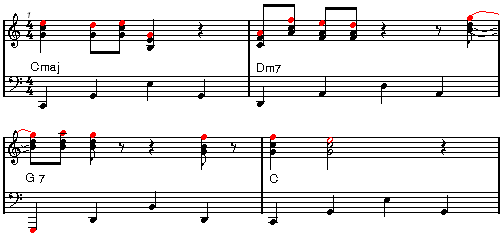Piano melody harmonisation using the right hand in pop and jazz songs
In this chapter I explain how to harmonize a melody of a pop, blues or jazz song. In jazz songs the harmonization follows the same concepts, but you can use more dissonances (ninth, sixth, seventh). With these techniques you can play any passage in a satisfactory way: also introducing the techniques for the left hand explained in the other pages succeeded in getting from the piano an orchestral sound.
With the left hand you play a bass line or an arpeggio, essentially based on the fundamental note of the chord, instead you put in prominence the melody with the right hand sustained by the chord that harmonizes the notes of the melody itself.
You put in prominence the rhythmic both with the left both with the right hand but you always remember to emphasize ( to stress) the upbeats.

- Now, I analyze how to harmonize a melody, considering the chords used in Western music are five types: major, minor, dominant seventh, half diminished and diminished. I suggest to learn piano chords and blues chords too.
General rules to harmonize the melody with the right hand
The rules I propose are:
- The melody has to be the top note of the chord
- You have to play the chord with the other fingers of the hand under the melody
- You have to use the notes of the chord that is under the melody
- If the melody is a note of the chord, you have to play a simple inversion of the chord
- If the melody is not a note of the chord (that is the fourth, the sixth or the ninth one) the preceding note is omitted (for example, if the melodic note is the sixth one it is better to omit the fifth one, if there is the fourth note omit the third one….)
- I suggest not to repeat the same note (two thirds, two fifths) in the chord.
- You can omit the fifth if it has not altered (diminished fifth, augmented fifth)
- It is better you harmonize more notes of the melody you can.
- It is not necessary to harmonize every single note of the melody (even if it would be more beautiful). Above all on fast songs the harmonization is difficult
- In fast songs harmonize at least one note of a new chord.
Here are examples of harmonization for each chord type
Harmonization of the melody with the various types of chord
Transpose this harmonization for every chord and harmonize all the notes of a major or minor key (example C major or E minor) with the chords of that key.
Harmonization with the major seventh chord

Play under each melodic note (top-note) the right inversion
Harmonize a melody with dominant seventh chord

Omit the note under the melody when it is very near the top note.
Ho to harmonize top notes with minor seventh chord

Do not double the notes of the chord.
Half diminished chord harmonization

Play these chords in all keys
Melody harmonization with diminished seventh chord

These exercises are the important both to perform both for improvising at the piano.
Practice to harmonize all the songs you want to the piano. I assure you that with this technique the sonorities of the piano express the maximum one. Brahms often repeated that if you play three notes (an chord) in the middle-up register of the piano, an orchestral ,very incisive, powerful, harmonic and pleasant sound results. The piano is the harmonic instrument for excellence and therefore these techniques of harmonization are fundamental for a pianist.
Example of harmonization of a melody

The notes of the melody are in red. In this example I have written a simple arpeggio accompaniment with the left hand. As you can notice some notes are not harmonized.
Here is finally another example (to add, be patient!) in which all notes of the melody are harmonized. Also in this case the left hand plays a simple arpeggio of the chord.
I conclude saying that Bill Evans has been insuperable on this technique. He succeeded in harmonizing the melodies of the themes or improvisation with sophisticated chords and in a continuous way: it played together three or four notes like the average of the pianists plays one note at a time. You can listen the result from his masterpieces that punctually make me feel deep emotions…


